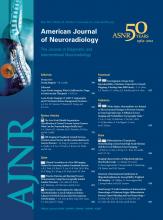A 32-year-old woman presented with vertical diplopia after a blunt head injury due to a vehicle crash. On examination 2 weeks after the trauma, she had a pupil-involving right third-nerve palsy. The absence of intorsion when looking downward starting from an abducted eye-in-orbit position suggested a concomitant fourth nerve palsy. T1-weighted brain MR imaging revealed marked gadolinium enhancement of the cisternal portion of the right oculomotor nerve (Fig 1). The trochlear nerve could not be visualized on the available scans.
Transverse and coronal T1-weighted images before (left) and after (middle and right) administration of gadolinium diethylene triamine pentaacetic acid. The cisternal segments of both oculomotor nerves are readily visible exiting the midbrain. Marked contrast enhancement appears in the right oculomotor nerve (arrows).
Mechanical compression and/or traction of cranial nerves may develop as a consequence of head trauma. Still, systematic studies of cranial nerve palsies after mild head injury are sparse. In a recent analysis by Coello et al,1 11.3% of patients with posttraumatic cranial nerve injuries had an oculomotor nerve palsy; 42.8% of these patients had at least 1 additional cranial nerve involvement. The most commonly associated nerve injury was to the trochlear nerve. Unfortunately, no MR imaging data are available from this study.
Oculomotor nerve enhancement is not uncommon in inflammatory conditions and in ophthalmoplegic migraine.2 On the other hand, the presence of cranial nerve enhancement after head injury is not systematically investigated. We could find only 1 case description of nerve enhancement after a presumed mild head injury concerning the hypoglossal nerve.3 Despite the lack of data in the clinical literature, contrast enhancement of injured nerves after traction or compression is well-known from animal experiments.4 Neuropathologic findings indicate that the intraneural edema caused by mechanical compression is a vasogenic edema induced by congesting venous blood flow and develops because of increased permeability of capillaries in the endoneurial space. In turn, leakage of endoneurial pressure appears to induce demyelination.4 Our case presents pathologic gadolinium enhancement of the third cranial nerve after a minor head injury, which probably reflects a trauma-induced local breakdown of the blood-nerve barrier, with consequent edema formation. Modern MR imaging techniques such as 3D constructive interference in steady state3 may help develop diagnostic algorithms for monitoring and treatment of cranial nerve palsies after head injury.
- © 2012 by American Journal of Neuroradiology













